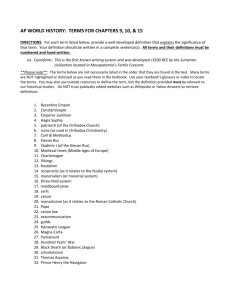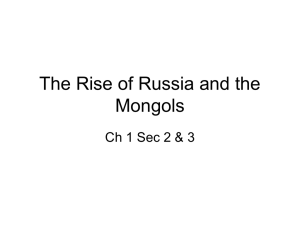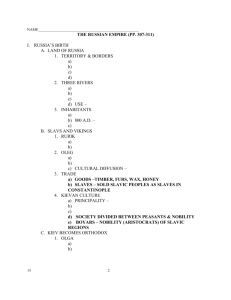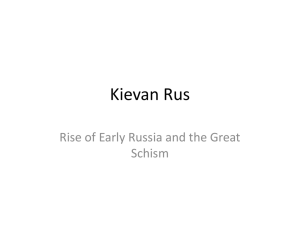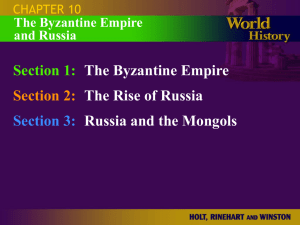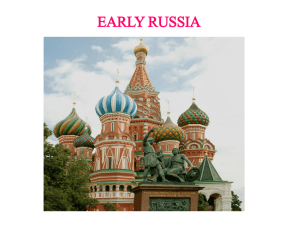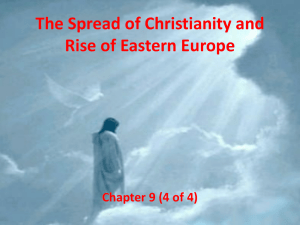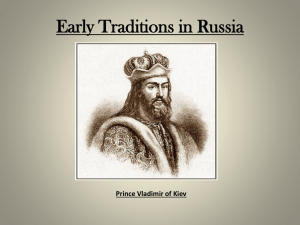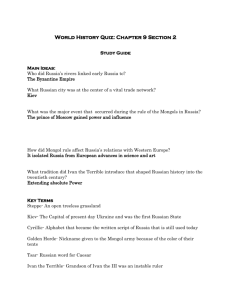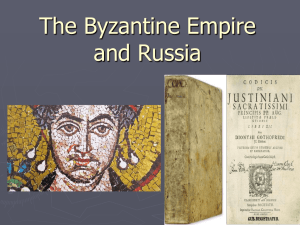Kievan Rus - Fort Bend ISD
advertisement
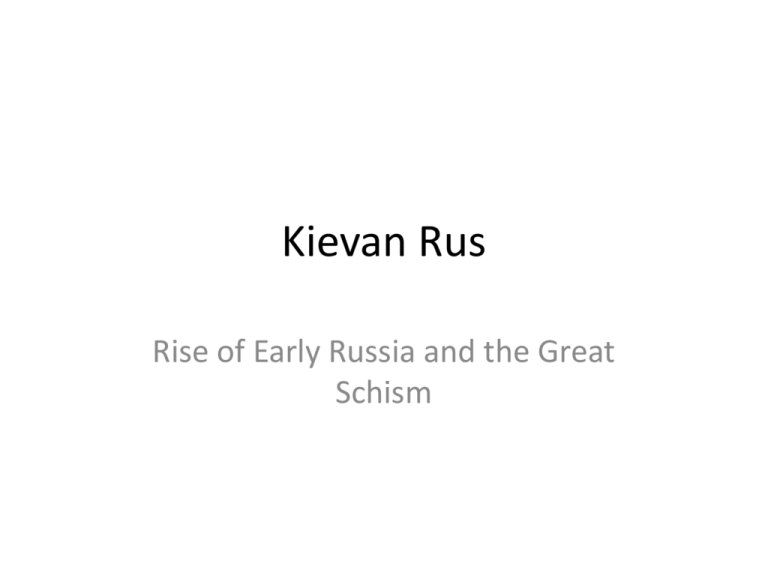
Kievan Rus Rise of Early Russia and the Great Schism Kievan Rus • Begun by invasion of Viking tribes – also known as Slavs – from north of the Baltic. • Both trade partner and sometime enemy of the Byzantine Empire. Kievan Rus Kievan Russia • Rurik, the leader of a people called the Rus, took control of Novgorod in A.D. 862. • Rurik and his successors soon came to rule over Kiev as well as over Slavic tribes along the Dnieper River. • The region under their control came to be called the Rus. The word Russia probably comes from this name. • Kiev prospered because of its location along the rich trade route between Constantinople and the Baltic Sea. • Kiev became the most important principality in Kievan Russia and served as the capital for nearly 300 years after about A.D. 879. • As early as A.D. 911, Kiev was powerful enough to win a favorable trade treaty with the Byzantine Empire. Kievan Russia Government • Many areas in Kievan Russia were led by princes who governed with the advice of councils made up of boyars, or nobles. • Another institution in Kievan Russia was the veche, or town meeting where important matters like wars, disputes between princes, or emergencies were discussed. • Yaroslav I, Yaroslav the Wise, ruled from A.D. 1019 to A.D. 1054, a great period in Russian history. • He built many churches and introduced Russia's first law code, the Pravda Russkia (the "Russian Justice"). • Yaroslav's code combined elements of tribal customs and older laws and traditions. It outlined lawful responses in cases of violence and other harmful activity. Yaroslav the Wise A Church Built by Yaroslav Religion • Traders and Greek missionaries brought Christianity to Kievan Russia in the A.D. 800s. • In the A.D. 980s the ruler Vladimir I sent observers to Christian church services in several places. • His officials were impressed with what they saw and Vladimir wanted to marry Anna, the sister of the Byzantine emperor. • In A.D. 988 he converted to Christianity. • After converting he ordered all Kievans to become Christians. He also had all pagan statues destroyed. Baptism of Vladimir I Religion continued… • The Byzantine church became a more and more important force in Kievan Russia. • The patriarch in Constantinople chose the bishop of the Kievan church. Monasteries became centers of religious thought, social service, and the arts. • When the Christian church split in A.D. 1054, the Kievans followed the Eastern Orthodox Church. • Religious themes dominated Kievan culture during this period. • Most writing focused on religion, in the form of hymns and sermons. • Icon painting became the most distinctive Kievan art form. Artists also created mosaics and frescoes. • Much of the decorative painting created by Kievan artists was designed to illustrate religious ideas and figures. Early Byzantine Influences: Orthodox Christianity Early Byzantine Influences: Orthodox Christianity Iconoclastic Controversy Economy • Kievan Russia included two major agricultural regions; the steppe and the taiga. • The grassy and mostly treeless plain in the south is called the steppe. • The steppe has black, fertile soil that is ideal for agriculture. • North of the steppe lies the taiga (ty·guh). • The taiga has great forests and receives much rainfall; winters are long and cold, and the growing season on the taiga is short. • The steppe gets less rain than the taiga, however, the steppe has a milder climate and a longer growing season. • People in the steppe had more time to plant and harvest crops. Taiga Russian Winters • Winter in Russia can be VERY cold and frigid. • The following photos are pictures of Kiev in the winter. Economy continued… • Kievan Russia traded agricultural goods and wood, iron, salt, furs, and honey with the Byzantines. • Kievan Russia also provided slaves for the Byzantines. • In return, the Kievans received goods such as wine, silk, spices, fruit, jewelry, silver, and textiles. • By the early A.D. 1000s, trade had helped Kievan Russia become a strong, wealthy power. • Several social classes emerged in Kievan Russia. • At the top were the local princes and their families, followed by the boyars, or nobles. Russian Boyars Russian Clergy • Next were the town artisans and merchants, who devoted themselves to trade. • The largest and lowest class, however, were the peasants. Peasants lived in small villages in the country and produced the crops that fed Kievan Russia. • The clergy formed another important group. Clergy performed religious ceremonies and ran hospitals and charities. Attacks on Kiev • Kiev had declined because Kievan rulers gave the outlying towns to their sons to rule independently. • In A.D. 1169 and A.D. 1203, groups of princes sacked Kiev, ruining the city's prosperity. New invaders, the Mongols, took advantage of Kiev's weakness. • The Mongols came from the Asian steppe east of the Ural Mountains. By A.D. 1240 they had conquered or destroyed almost every city in Kievan Russia. • Mongols controlled Kievan Russia until the late A.D. 1400s. Ivan the Great • In time Mongol rule grew weaker. The princes of the region became more independent. • From A.D. 1462 to A.D. 1505 Ivan III, also called Ivan the Great, ruled as Great Prince. • By this time Moscow had begun to assert its independence from the Mongols. The Rise of Moscow • By A.D. 1480 Ivan III no longer acknowledged the Mongol khan as Moscow's supreme ruler. • Ivan III became the first ruler of the independent state called Russia. • He gained more territory through military conquest. • His rule began a long tradition of absolute monarchy in Russia. Ivan the Great (r. 1462-1505) Ivan III Tearing the Great Khan’s Letter Requesting More Tribute in 1480. Ivan the Terrible • (1530-1584) Ivan the Terrible Centralized royal power • Introduced new laws that tied Russian serfs to the land • Used agents of terror to consolidate his power • Had thousands of people killed because he suspected a plot. Discussion Questions: • Why was early Russia strongly influenced by the Byzantine Empire? • How did Orthodox Christianity come to be the major religion in Russia? • What importance did geography have in the development of Kiev as a powerful city?
